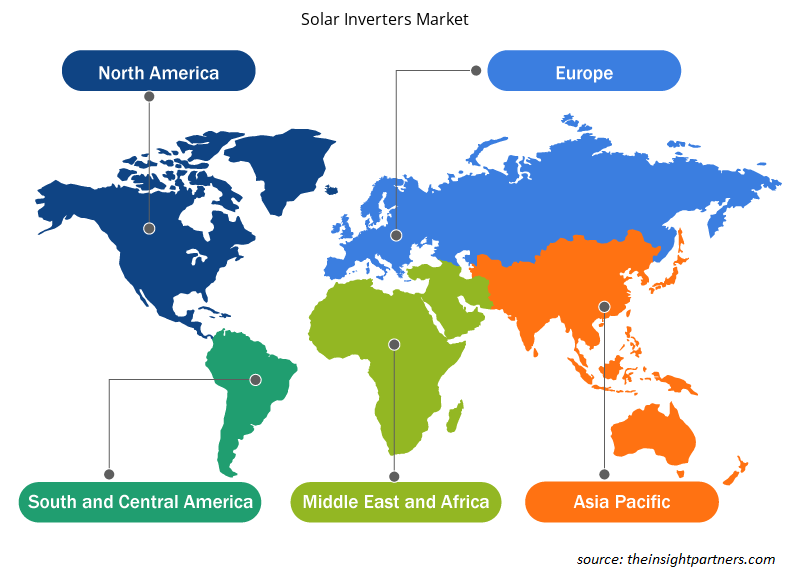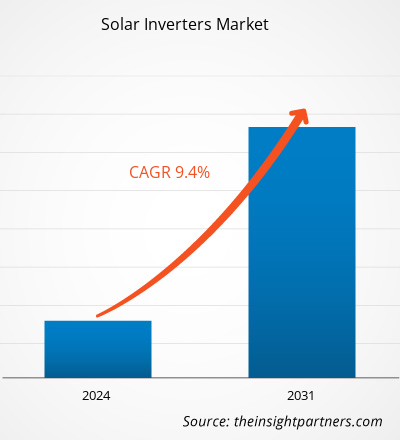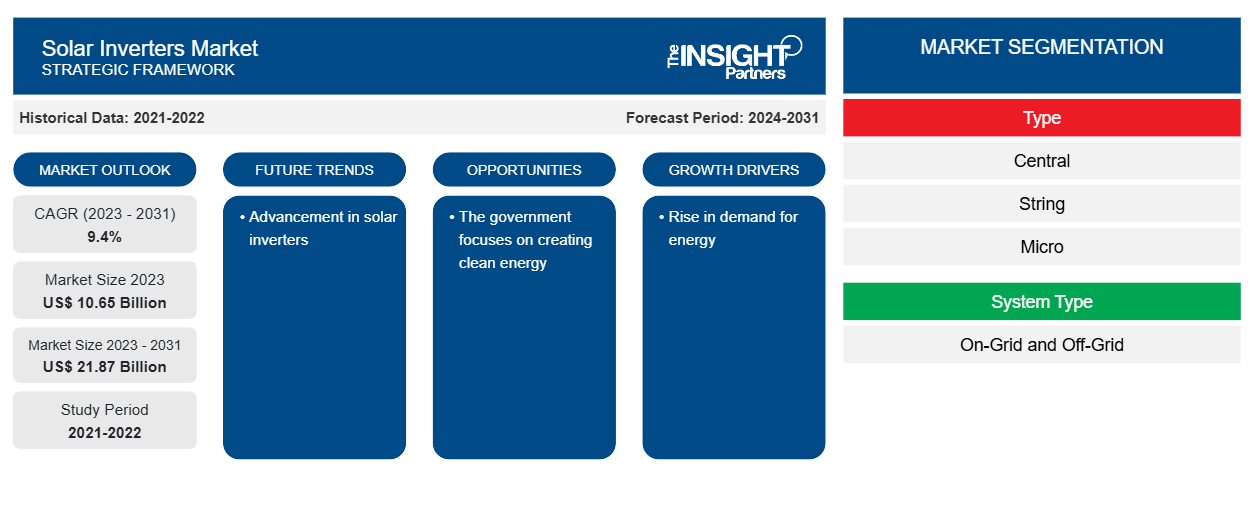Se prevé que el tamaño del mercado de inversores solares alcance los 21.870 millones de dólares en 2031, frente a los 10.650 millones de dólares en 2023. Se espera que el mercado registre una CAGR del 9,4 % durante el período 2023-2031. Es probable que la creciente necesidad de soluciones de energía limpia y el aumento de las iniciativas gubernamentales para instalar inversores solares sigan siendo tendencias clave en el mercado.
Análisis del mercado de inversores solares
El aumento de la inversión en energía solar es uno de los principales factores que impulsan el mercado de inversores solares. Por ejemplo, en abril de 2024, el Departamento del Interior de Estados Unidos anunció una inversión de 19 millones de dólares de la agenda Investing in America del presidente Biden para instalar paneles solares sobre canales de riego en California, Oregón y Utah, reduciendo simultáneamente la evaporación de suministros de agua críticos y avanzando en los objetivos de energía limpia. Además, la creciente instalación de tecnología solar en tejados en el sector residencial está impulsando el crecimiento del mercado. El hecho de que el gobierno proporcione subsidios para la instalación de tecnología solar fomenta aún más el crecimiento del mercado de inversores solares.
Descripción general del mercado de inversores solares
Un inversor solar, también conocido como fotovoltaico
(
El inversor fotovoltaico es un tipo de inversor de potencia que obtiene energía de la luz solar. Convierte la corriente continua fotovoltaica variable en corriente alterna que proporciona energía a la red ) inverter, is a type of power inverter that sources energy from sunlight. It converts the variable photovoltaic DC current into the AC current that provides the energy to the commercial eléctrica comercial o se utiliza en una red eléctrica local fuera de la red. La necesidad de energía limpia está creciendo en todo el mundo para reducir los efectos ambientales negativos. Este factor fomenta la demanda de energía solar, que impulsa aún más el mercado de inversores solares.
Personalice este informe según sus necesidades
Obtendrá personalización en cualquier informe, sin cargo, incluidas partes de este informe o análisis a nivel de país, paquete de datos de Excel, así como también grandes ofertas y descuentos para empresas emergentes y universidades.
-
Obtenga las principales tendencias clave del mercado de este informe.Esta muestra GRATUITA incluirá análisis de datos, desde tendencias del mercado hasta estimaciones y pronósticos.
Perspectivas regionales del mercado de inversores solares
Los analistas de Insight Partners explicaron en detalle las tendencias y los factores regionales que influyen en el mercado de inversores solares durante el período de pronóstico. Esta sección también analiza los segmentos y la geografía del mercado de inversores solares en América del Norte, Europa, Asia Pacífico, Oriente Medio y África, y América del Sur y Central.

- Obtenga datos regionales específicos para el mercado de inversores solares
Alcance del informe de mercado de inversores solares
| Atributo del informe | Detalles |
|---|---|
| Tamaño del mercado en 2023 | US$ 10,65 mil millones |
| Tamaño del mercado en 2031 | US$ 21.87 mil millones |
| CAGR global (2023 - 2031) | 9,4% |
| Datos históricos | 2021-2022 |
| Período de pronóstico | 2024-2031 |
| Segmentos cubiertos |
Por tipo
|
| Regiones y países cubiertos |
América del norte
|
| Líderes del mercado y perfiles de empresas clave |
|
Densidad de actores del mercado de inversores solares: comprensión de su impacto en la dinámica empresarial
El mercado de inversores solares está creciendo rápidamente, impulsado por la creciente demanda de los usuarios finales debido a factores como la evolución de las preferencias de los consumidores, los avances tecnológicos y una mayor conciencia de los beneficios del producto. A medida que aumenta la demanda, las empresas amplían sus ofertas, innovan para satisfacer las necesidades de los consumidores y aprovechan las tendencias emergentes, lo que impulsa aún más el crecimiento del mercado.
La densidad de actores del mercado se refiere a la distribución de las empresas o firmas que operan dentro de un mercado o industria en particular. Indica cuántos competidores (actores del mercado) están presentes en un espacio de mercado determinado en relación con su tamaño o valor total de mercado.
Las principales empresas que operan en el mercado de inversores solares son:
- FIMER SpA.
- Electrónica Delta, Inc.
- Enertechups
- BUENO
- Electrónica de potencia SL
- Powerone Micro Systems Pvt. Ltd
Descargo de responsabilidad : Las empresas enumeradas anteriormente no están clasificadas en ningún orden particular.

- Obtenga una descripción general de los principales actores clave del mercado de inversores solares
Noticias y desarrollos recientes del mercado de inversores solares
El mercado de inversores solares se evalúa mediante la recopilación de datos cualitativos y cuantitativos a partir de una investigación primaria y secundaria, que incluye importantes publicaciones corporativas, datos de asociaciones y bases de datos. A continuación, se enumeran algunos de los avances en el mercado de inversores solares:
- INVTSolar lanzó con éxito su último producto, el inversor para conexión a red XG1-5kW-S, en el SolarQuarter State Business Meet 2023 celebrado en India. INVTSolar ganó el premio "State Leadership Awards 2023- Gujarat", que demostró su profunda acumulación técnica, su sólida capacidad de I+D y sus logros sobresalientes: el inversor solar monofásico para conexión a red XG1-5KTL-S. (Fuente: NTT Ltd, comunicado de prensa, diciembre de 2023)
- Colt Data Centre Services (DCS), un proveedor global de soluciones de centros de datos de gran escala y para grandes empresas, anunció el lanzamiento de su primer centro de datos en India. El centro de datos insignia de Navi Mumbai marca la expansión estratégica de Colt DCS y su compromiso de respaldar la creciente demanda de proveedores de servicios en la nube de gran escala y grandes empresas en el mercado de centros de datos de la India, que está creciendo rápidamente. El centro de datos cuenta con una subestación GIS de 220 kV altamente resistente en el sitio con configuración LILO. (Fuente: Colt Data Centre Services Holdings, comunicado de prensa, septiembre de 2023)
Informe sobre el mercado de inversores solares: cobertura y resultados
El informe “Tamaño y pronóstico del mercado de inversores solares (2021-2031)” proporciona un análisis detallado del mercado que cubre las siguientes áreas:
- Tamaño del mercado de inversores solares y pronóstico a nivel global, regional y nacional para todos los segmentos clave del mercado cubiertos bajo el alcance
- Tendencias del mercado de inversores solares, así como dinámicas del mercado, como impulsores, restricciones y oportunidades clave
- Análisis detallado de las cinco fuerzas de Porter y PEST y FODA
- Análisis del mercado de inversores solares que cubre las tendencias clave del mercado, el marco global y regional, los principales actores, las regulaciones y los desarrollos recientes del mercado.
- Análisis del panorama de la industria y de la competencia que abarca la concentración del mercado, el análisis de mapas de calor, los actores destacados y los desarrollos recientes del mercado de inversores solares
- Perfiles detallados de empresas
- Análisis histórico (2 años), año base, pronóstico (7 años) con CAGR
- Análisis PEST y FODA
- Tamaño del mercado, valor/volumen: global, regional y nacional
- Industria y panorama competitivo
- Conjunto de datos de Excel
Informes recientes
Informes relacionados
Testimonios
Razón para comprar
- Toma de decisiones informada
- Comprensión de la dinámica del mercado
- Análisis competitivo
- Información sobre clientes
- Pronósticos del mercado
- Mitigación de riesgos
- Planificación estratégica
- Justificación de la inversión
- Identificación de mercados emergentes
- Mejora de las estrategias de marketing
- Impulso de la eficiencia operativa
- Alineación con las tendencias regulatorias























 Obtenga una muestra gratuita para - Mercado de inversores solares
Obtenga una muestra gratuita para - Mercado de inversores solares